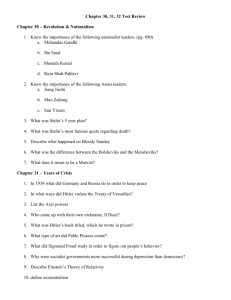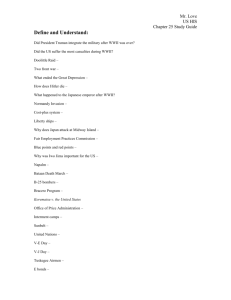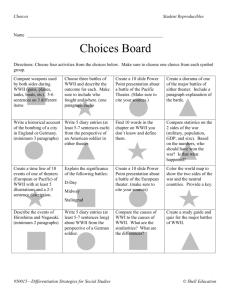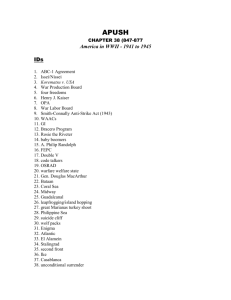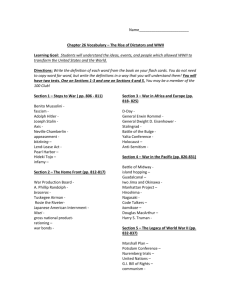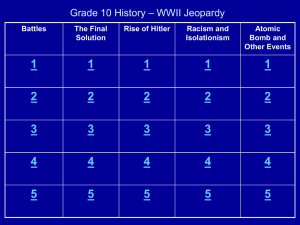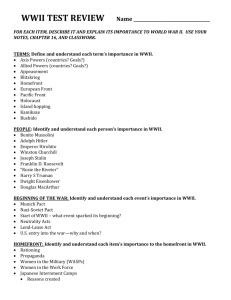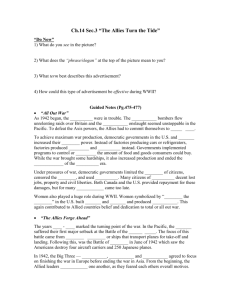topic - Cheney USD 268
advertisement
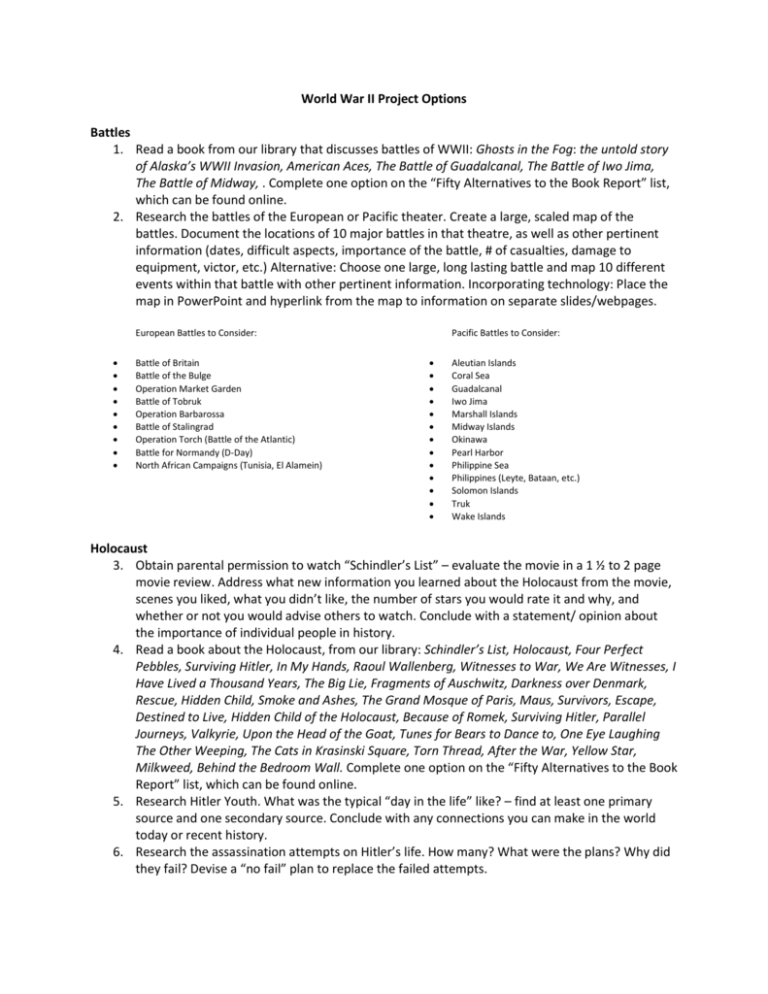
World War II Project Options Battles 1. Read a book from our library that discusses battles of WWII: Ghosts in the Fog: the untold story of Alaska’s WWII Invasion, American Aces, The Battle of Guadalcanal, The Battle of Iwo Jima, The Battle of Midway, . Complete one option on the “Fifty Alternatives to the Book Report” list, which can be found online. 2. Research the battles of the European or Pacific theater. Create a large, scaled map of the battles. Document the locations of 10 major battles in that theatre, as well as other pertinent information (dates, difficult aspects, importance of the battle, # of casualties, damage to equipment, victor, etc.) Alternative: Choose one large, long lasting battle and map 10 different events within that battle with other pertinent information. Incorporating technology: Place the map in PowerPoint and hyperlink from the map to information on separate slides/webpages. European Battles to Consider: Battle of Britain Battle of the Bulge Operation Market Garden Battle of Tobruk Operation Barbarossa Battle of Stalingrad Operation Torch (Battle of the Atlantic) Battle for Normandy (D-Day) North African Campaigns (Tunisia, El Alamein) Pacific Battles to Consider: Aleutian Islands Coral Sea Guadalcanal Iwo Jima Marshall Islands Midway Islands Okinawa Pearl Harbor Philippine Sea Philippines (Leyte, Bataan, etc.) Solomon Islands Truk Wake Islands Holocaust 3. Obtain parental permission to watch “Schindler’s List” – evaluate the movie in a 1 ½ to 2 page movie review. Address what new information you learned about the Holocaust from the movie, scenes you liked, what you didn’t like, the number of stars you would rate it and why, and whether or not you would advise others to watch. Conclude with a statement/ opinion about the importance of individual people in history. 4. Read a book about the Holocaust, from our library: Schindler’s List, Holocaust, Four Perfect Pebbles, Surviving Hitler, In My Hands, Raoul Wallenberg, Witnesses to War, We Are Witnesses, I Have Lived a Thousand Years, The Big Lie, Fragments of Auschwitz, Darkness over Denmark, Rescue, Hidden Child, Smoke and Ashes, The Grand Mosque of Paris, Maus, Survivors, Escape, Destined to Live, Hidden Child of the Holocaust, Because of Romek, Surviving Hitler, Parallel Journeys, Valkyrie, Upon the Head of the Goat, Tunes for Bears to Dance to, One Eye Laughing The Other Weeping, The Cats in Krasinski Square, Torn Thread, After the War, Yellow Star, Milkweed, Behind the Bedroom Wall. Complete one option on the “Fifty Alternatives to the Book Report” list, which can be found online. 5. Research Hitler Youth. What was the typical “day in the life” like? – find at least one primary source and one secondary source. Conclude with any connections you can make in the world today or recent history. 6. Research the assassination attempts on Hitler’s life. How many? What were the plans? Why did they fail? Devise a “no fail” plan to replace the failed attempts. Name: 7. Research the Japanese Ofura camp and compare and contrast to a German concentration camp – display your findings. Conclude by judging which would be the worst situation. 8. Compare Doctor Kitamura from Japan to Doctor Mengele from Germany. Who, what, when, where, why? Actions? Reasons? Purpose? Speculate on how this could actually take place. 9. Research the Nuremburg Trials. Highlight the proceedings for some of the “big names” and their sentencing. Discuss the pros and cons of these proceedings. Was this sentence justified? Why or why not? Home Front 10. Compare the costs of common consumer goods during the 1940s and today (approximately 2530). Analyze the percentage of change in the costs of goods. Formula: (cost today-cost then)/cost then x 100. Categorize items: which items are actually more affordable now? Then? 11. Interview a “real-life” Rosie the Riveter. Share her story in a creative way; perhaps in a tribute to her contributions to the war. Conclude: how would you portray her? What does she represent? 12. Interview a WWII veteran. Share his story in a creative way; perhaps in a tribute to his contributions to the war. Conclude: how would you portray him? What does he represent? 13. Read a book about the internment of Japanese Americans during WWII, from our library: Desert Exile, The Journal of Ben Uchida, Weedflower, The Fences Between Us, A Boy No More. Complete one option on the “Fifty Alternatives to the Book Report” list, which can be found online. Military Leaders 14. Pick a military general from any country during WWII. If you would like to choose another individual, you will just need to check with Mrs. Hibbs. The “usual” Hitler and FDR are not options. Bernard Montgomery Erwin Rommel George Patton Charles De Gaulle Hideki Tojo Mark W. Clark Chester Nimitz Heinrich Himmler Omar Bradley Douglas MacArthur John Wainwright Dwight D. Eisenhower George Marshall Research the leader, and imagine this leader is applying for his next position in the military or government. For any job, one must have an impressive résumé. Your task is to write the résumé for this leader. Identify the job he is seeking, 10+ accomplishments, applicable education, what was accomplished, how it was accomplished, as well as the impact it made on the war. To create the résumé, decide how you are going to manipulate the research information to make this leader look appealing for his next job. 15. Read a book about the military during WWII, from our library: Flyboys. Complete one option on the “Fifty Alternatives to the Book Report” list, which can be found online. Patriotism 16. Research the 1936 Olympics in Berlin: Hitler’s attitudes and actions, Nazi propaganda, discussion of boycott, Jesse Owens, Jewish athletes on the German team and their fate after the Olympics. Critique the Olympics: what went well, what didn’t go well, should the U.S. have boycotted? 17. Read Triumph, the untold story of Jesse Owens and Hitler’s Olympics. Complete one option on the “Fifty Alternatives to the Book Report” list, which can be found online. 18. Research Bob Hope and the USO, and other performers of the USO – what was its purpose, how was it accomplished, who performed, can you incorporate clips of shows or songs? How is the USO still active today – who are recent performers, where did they perform? Share your opinion: is the USO and other similar organizations a necessity? Why or why not? Mrs. Hibbs Name: 19. Research WWII memorials in the United States and around the world. Showcase your findings; Materials used? Cost? Symbolism? Details about the person/event, and its significance. Explain the importance of memorials; who or what do you think should have a memorial that currently does not? 20. Compare and contrast the bombing at Pearl Harbor to the attack on 9/11. Judge which event was more heinous, and defend your reasoning. POW Camps 21. Research American POWs from WWII – find at least one primary source and at least two primary sources – share the experiences of the POWs. Devise a way these POWs could have been saved. 22. Research POWs and the Geneva Convention – compare the actual treatment of POWs to the way they were supposed to be treated. 23. Research the Omori POW camp – what was it like, who was in charge, what diseases were rampant, how many died, acts of sabotage. How would you grade the camp in terms of its treatment of soldiers? Living quarters? Food? Etc. 24. Research the Bataan Death March – find at least one primary source and two secondary sources – document the experiences of those POWs. If you had been in this situation, would you have survived to see liberation? Explain your reasoning. Weapons, Medicine and Technology 25. Compare and contrast the B17 to the B24 to the B29 in terms of capabilities, crew requirements/jobs, safety, nickname. Rank each in terms of the war effort. 26. Read about Operation Little Vittles in The Candy Bomber from our library. Complete one option on the “Fifty Alternatives to the Book Report” list, which can be found online. 27. Research the Los Alamos Laboratory and the Trinity test. Major players, timeline of development, testing procedures, decision to use. What choice would you have made as president in this situation? 28. Research and rank weapons that made a marked impact on the outcomes of WWII. Why was each so effective? Who invented? How has each been improved upon/replaced by since? 29. Research medical breakthroughs that reduced the death rate of wounded soldiers during WWII. What was available prior to WWII? What was developed during WWII? How have these advances been furthered since? 30. Research the practice of eugenics in the United States. Who? What? When? Where? Why? Examples? Compare and control this to Hitler’s plan for a perfect race. What is your opinion on the practice? 31. Read a book about the atomic bomb: Sadako and the thousand paper cranes. Learn how to make an origami crane and teach the class. 32. Read a book about the atomic bomb: Hiroshima, or The Bomb. Complete one option on the “Fifty Alternatives to the Book Report” list, which can be found online. Women 33. Research “Flygirls” in WASP (Fifinella, Bessie Coleman, etc.) – their training, roles, jobs, impact, and the museum devoted to them. Display your findings. Conclude with: How would you portray these women? What do they represent? 34. Research the women’s baseball league during WWII and the memorial in their honor. Display your findings. Conclude with: How would you portray these women? What do they represent? What should they have done after the war ended? Mrs. Hibbs Name: 35. Read a book about the women in the military during WWII, from our library: Flygirl. Complete one option on the “Fifty Alternatives to the Book Report” list, which can be found online. 36. Research Rosie the Riveter, real life “Rosies,” and their impact on the war – maybe incorporate the Rosie the Riveter song in your project. Conclude: How would you portray these women? What do they represent? 37. Research 1940s fashion, and how rationing impacted fashion. Model or sketch similar fashions. Consider zoot suits made and contrast this with the idea of rationing. What statement were zoot suiters making? Were the zoot suit riots justified? Why or why not? Miscellaneous 38. Research companies that “supported” the Nazis by giving or selling them goods. Display this information. Should U.S. citizens have boycotted these companies? Why or why not? 39. Research camouflage techniques used during WWII. Think beyond clothing; weapons, ships, factories, cities…Rate the effectiveness of each. 40. Research the Nazi theft of valuable art during WWII. Who? What? When? Where? Why? What art has been recovered? What art is still missing? What is the value of the missing art? How would you generate a plan to recover what is still missing? 41. Research Swiss neutrality and the Nazi use of these Swiss banks. Who was involved? What banks were involved? What was deposited there? Does this make the idea of Swiss neutrality “a myth?” When will this be settled? What would you suggest should be done about this situation? Mrs. Hibbs
